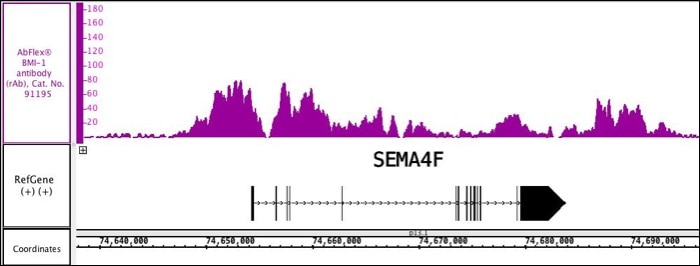AbFlex BMI-1 antibody (rAb)
Host / Isotype
Mouse / IgG2a
Reactivity
Human, Mouse
Applications
ChIP, ChIP-Seq, WB
Cat No : 91195,91196 91195
Synonyms
Validation Data Gallery
Product Information
| Tested Applications |
ChIP, ChIP-Seq, WB
Applications Validated by Active Motif: ChIP-Seq: 4 ug per ChIP WB*: 0.5-2 ug/ml dilution *Note: many chromatin-bound proteins are not soluble in a low salt nuclear extract and fractionate to the pellet. Therefore, we recommend a High Salt / Sonication Protocol when preparing nuclear extracts for Western Blot. AbFlex recombinant antibodies are genetically derived from DNA sequences of parental hybridoma clones. For details on the parental clone, see Catalog No. 39993. |
| Tested Reactivity | Human, Mouse |
| Host / Isotype | Mouse / IgG2a |
| Class | Recombinant |
| Type | Antibody |
| Immunogen | This antibody was raised against full length human BMI1 [BMI1 polycomb ring finger oncogene]. |
| Full Name | AbFlex BMI-1 antibody (rAb) |
| Synonyms | BMI-1, BMI 1, BMI1, Polycomb, PRC1 complex, silencing, E3 ubiquitin protein ligase, RNF2, RING2, resulting in the ubiquitylation, histone H2A at lysine 119, H2AK119Ub, oncogene, lymphoma, metastatic melanoma, hematopoietic stem cell self renewal, stem cell, stem cells |
| Molecular weight | |
| GenBank accession number | NP_005171 |
| RRID | AB_2793798 |
| Purification Method | Protein A Chromatography |
| Buffer | Purified IgG in 140 mM Hepes, pH 7.5, 70 mM NaCl, 35 mM NaOAc, 0.07% sodium azide, 30% glycerol. Sodium azide is highly toxic. |
| Storage | Some products may be shipped at room temperature. This will not affect their stability or performance. Avoid repeated freeze/thaw cycles by aliquoting items into single-use fractions for storage at -20°C for up to 2 years. Keep all reagents on ice when not in storage. |
Background Information
AbFlex antibodies are recombinant antibodies (rAbs) that have been generated using defined DNA sequences to produce highly specific, reproducible antibodies. Each AbFlex antibody contains a 6xHis Tag, a Biotinylation Tag for enzymatic biotin conjugation using the biotin ligase, BirA, and a sortase recognition motif (LPXTG) to attach a variety of labels directly to the antibody including fluorophores, enzymatic substrates (HRP, AP), peptides, drugs as well as solid supports. BMI-1 is a member of the Polycomb PRC1 complex that is recruited to transcriptionally repressed genes subsequent to histone H3 lysine 27 methylation in order to maintain repression. In the PRC1 complex, BMI-1 is required to stimulate the E3 ubiquitin-protein ligase activity of RNF2/RING2, resulting in the ubiquitylation of histone H2A at lysine 119. BMI-1 acts as an oncogene and cooperates with c-myc in the initiation of lymphoma. High levels of expression of BMI-1 are observed in metastatic melanoma, and BMI-1 has been implicated in several other cancers. BMI-1 is required for hematopoietic stem cell self renewal.


